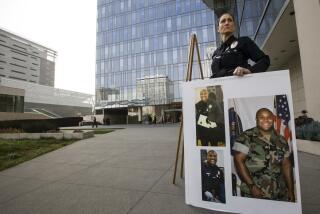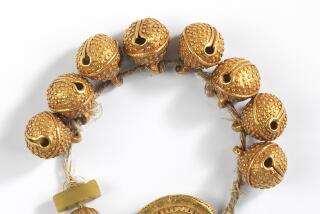Mandela gun a draw at South Africa home auction
- Share via
Reporting from Johannesburg, South Africa — He has an illegal Soviet gun and 200 rounds of ammunition. He’s just returned from a military training camp in northern Africa and he’s planning to blow things up.
He’s a hero to his followers, but a terrorist to the government. And police are closing in.
So, hide the gun and ammo.
He steps out the back door of the rural farmhouse hide-out, paces out 20 steps and digs a deep pit on the edge of a field. He oils the weapon, wraps it in plastic and foil, then in khaki cloth, places it in the hole and covers it carefully with a piece of tin to deflect the rain.
He’s just learned to shoot, and he likes the gun. He’ll be back for it soon.
His name is Nelson Mandela. The gun, a Makarov semiautomatic pistol. Within weeks, in August 1962, he’s arrested, charged and — narrowly missing the hangman’s noose — imprisoned, for 27 years.
Decades later, the location of Mandela’s Makarov remains a tantalizing mystery. The house next door to Mandela’s old hide-out at Liliesleaf Farm was bought and demolished by a historical trust, its yard dug up and scoured for the pistol, which according to one valuation is worth $2 million to $3 million.
Nothing was found.
And on Thursday, the next house down, 5 George Ave., was put up for auction before several dozen historians, speculators and curious bystanders — with at least two potential international bidders participating by phone — at a corporate function center.
“Is the gun there or is the gun not there? We don’t know,” said auctioneer Joff van Reenen, launching the bidding.
The faded Spanish-style house, built in the early 1970s, has been coveted as the likely repository of the weapon since it failed to turn up under the house next door.
Longtime owner Al Leenstra, 78, never went digging for the gun (it’s believed to be right under his house) before finally deciding to put the abode on the market. Interest was high, the auctioneer enthused, as the home went under the hammer along with several vacant factories and multistory city blocks packed with illegal squatters.
Among those in attendance was Nicholas Wolpe, founder of the trust that restored Liliesleaf Farm, the secret base used by Mandela, and turned it into a museum. As bidding started, he feared that a valuable part of South Africa’s history could slip out of reach forever, even leave the country.
Wolpe’s uncle, James Kantor, was head of the African National Congress military intelligence wing based at the farm in the early 1960s. Wolpe’s father, Harold, was Mandela’s lawyer and set up a white farm couple as “owners” of the property.
Mandela was imprisoned for conspiracy and sabotage after the “Rivonia” trial, named for the rural area surrounding the farmhouse. These days, Rivonia, north of Johannesburg, is a well-to-do suburb.
Mandela, released from prison in 1990, was at Liliesleaf with journalist Alistair Sparks in 1993 when he suddenly recalled the gun, given to him by his Ethiopian military trainer. They paced it out, but at 10 paces they hit the brick wall of the house that has since been demolished.
Mandela was one of several key figures in the ANC who contended in the early 1960s that the only way to defeat apartheid was a military campaign of bombings and attacks. His recent book, “Conversations with Myself,” contains the transcript of a conversation about his training in Ethiopia.
“I spent two months there and I was taught how to fire various guns at different targets and then a moving target, you see,” he said.
Wolpe, who founded the Liliesleaf Trust in 2001, learned about the pistol when Mandela visited in 2003 and asked whether he’d ever found it.
“It was very matter of fact. We were walking and it just dawned on him. I was stunned, like, ‘Gun? What gun?’ He stopped and he turned and said, ‘It’s over there,’ and pointed at a 45 degree angle.”
Two years later, Mandela came back, and again pointed in the same general direction. The trust bought and demolished the neighboring house a few months later.
“You go from this absolute high to this absolute low. I felt extremely disappointed, thinking, ‘We’re never going to find this gun,’ ” Wolpe said.
In April, Wolpe brought in a military consultant from overseas who analyzed the area and advised that the burial place could be one of two locations on Liliesleaf land or, more likely, was under Leenstra’s house.
Leenstra, a businessman born in the Netherlands, had raised three children in the home. Then, semi-retired, he had moved to a smaller house and rented out 5 George Ave. Wolpe figured the house was worth about $440,000, and talked to Leenstra about an option, but no deal emerged and Leenstra decided to dispose of the property.
As Wolpe and Leenstra looked on, auctioneer Van Reenen started the bidding Thursday at 2 million rand (about $290,000). He spoke of the insurmountable historical value of the missing gun. Or tried to.
“Have it at two, sir? Think of the legend, sir! Selling at two now.”
Silence.
“It’s a one-horse race,” he said. Actually, there were no horses.
“We are asking you to bid 2 million to start.”
But no one did, not even the international bidders on the phone, including one from the United States.
Perhaps South Africa’s law was an issue: The pistol might be deemed a heritage item and its export banned, though South African law does not restrict the ownership or sale of important historical items.
Leenstra, smiling bravely after the auctioneer moved on to the next item, said he would not sell at 2 million rand and would probably hang on to the property and continue renting it out.
Wolpe, smiling with relief, felt the trust was just a bit closer to getting its hands on the gun.
If it’s there, that is.
More to Read
Sign up for Essential California
The most important California stories and recommendations in your inbox every morning.
You may occasionally receive promotional content from the Los Angeles Times.













